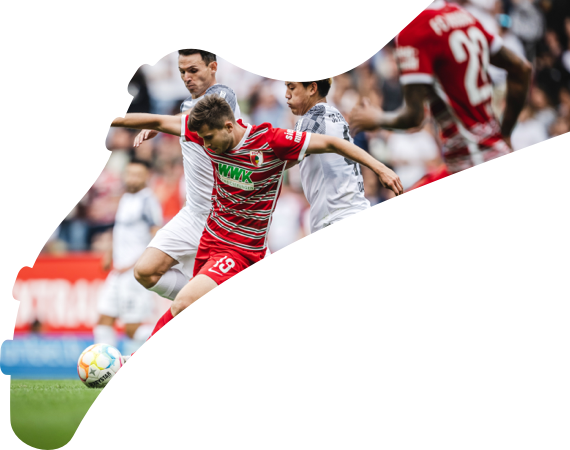
Hamburg vs. St. Pauli: worlds apart in Germany’s second city derby
It’s almost a century since Hamburger SV and FC St. Pauli first faced each other in their current forms, on 19 October 1924. The two biggest clubs in Germany’s second most populated city behind Berlin may once again be competing for promotion in Bundesliga 2 in 2023/24, but the pair are poles apart in almost every other respect – which makes the Hamburg derby such an eye-catching fixture.
That being said, the rivalry didn’t really exist in the clubs' early years. Yes, they wanted to beat each other, but from the creation of Hamburger SV in 1919 out of a merger between three other clubs, they were the dominant force in the area. Prior to the creation of the Bundesliga in 1963 – of which HSV were founding members – there were more seasons where they won their league (either city or later regional) than they didn’t.
The fact the first seven encounters with Pauli – themselves officially created in 1924 after splitting from athletics club Hamburg-St. Pauli Turnverein – all took place in a city league of eight teams meant that all fixtures were local derbies. And given that HSV won the first seven encounters by an aggregate score of 43-6, there was little in the way of rivalry.
Following the Second World War, Die Rothosen continued to dominate their league, but Pauli had now become a sporting challenger and, in fact, won the city league ahead of HSV in 1946/47 with a side often referred to now as a “miracle team”. They remained the closest on-pitch rivals, but Hamburg proved almost untouchable in the Oberliga Nord, finishing as champions of the regional division in all but one year from 1947 until they stepped up to the newly created nationwide Bundesliga in 1963.
In the years leading up to that, HSV had also won their third national championship, reached the semi-finals of the 1960/61 European Cup in their first participation – only losing to Barcelona in a tie-breaking third match – and won the DFB Cup for the first time as the great Uwe Seeler averaged 34 goals a season over eight years. However, HSV’s success meant that Pauli wouldn’t be able to play in the new Bundesliga as only one club per city was permitted, regardless of their own performances.
Find out more about HSV in our Bundesliga60 clubs series
Pauli would therefore remain in the second-tier Regionalliga Nord from its creation in 1963 until its conversion into Bundesliga 2 in 1974. They topped the table in four seasons but failed to make the leap up to the Bundesliga via the play-off system at the time. It meant between 1963 and St. Pauli’s first top-flight promotion in 1977, there were only two derby meetings. Those came in the group stage of the inaugural DFB Ligapokal in 1972/73. HSV won 4-1 at the Millerntor before a goalless draw in the return game on their way to winning the competition.
Pauli’s eventual arrival in the Bundesliga meant there would finally be a top-flight derby. And in fact, the promoted club won 2-0 away from home for their first victory over HSV in more than 17 years. The Rückrunde match was also played at the Volksparkstadion with Hamburg the nominal away team winning 3-2.
Find out more about St. Pauli in our Bundesliga60 clubs series
St. Pauli had already been struggling financially when they came up to the Bundesliga, and their stay lasted only a year as they went back down in last place. A second straight relegation to the third tier followed due to those financial issues, despite finishing sixth in the league – the year HSV won their first Bundesliga title with a team featuring Rudi Kargus, Manfred Kaltz, Jimmy Hartwig, Felix Magath, Horst Hrubesch and Ballon d’Or winner Kevin Keegan.
While Hamburg became one of the dominant sides in Germany and also Europe – reaching four continental finals in seven years across the late 70s and early 80s, even winning the 1982/83 European Cup – Pauli were still in the wilderness, flitting between the second and third tiers.
Their goalkeeper at the time, Volker Ippig, even described the relationship between Pauli and HSV as “normal” at the start of the 80s, and the teams would contest friendly matches against each other.
It was not much later that the mood began to change in Hamburg.
Football terraces became rather unsavoury places in Germany in the 1980s, with right-wing extremism prevalent among hardcore ultra fan groups – and HSV was no exception. People therefore started to look elsewhere for alternatives. In Hamburg, that led them to the Millerntor in the neighbourhood of St. Pauli.
The club became a haven for left-wing and alternative supporters, with one fan by the name of ‘Doc Mabuse’ bringing a skull and crossbones flag to games that quickly became synonymous with Pauli. Once displayed by pirates, fans of the port city club were positioning themselves as the outcast underdog taking on the rich and powerful.
In contrast to other clubs, fan groups were also vocal about political beliefs. There were active interventions against sexist or racist abuse in the stadium, with Pauli becoming the first club to include bans for such actions in its stadium regulations.
It is this approach of wanting to be inclusive, different and anti-establishment, its stance on integration and combatting hate and discrimination, that has helped develop Pauli’s reputation in Germany and around the world, that has constantly attracted fans despite its general lack of sporting success.
The football scene in Germany has obviously changed a lot since the 80s, and there is no suggestion from even Pauli supporters that HSV are a right-wing club. The Hamburg derby is not in fact a political battle. As one Pauli fan told DW in 2018: “It’s rather a clash of visions as to how football should be managed.”
In that respect it’s a similar rivalry to that now seen in Germany's capital with ‘big city club’ Hertha in old West Berlin, who regard themselves as a team for the whole city, being challenged by Union from the Köpenick district in East Berlin. There, too, there are social variances behind the differences.
The second city derby returned to the footballing calendar in 1988 when the Kiezkicker – literally, neighbourhood footballers – made it back to the Bundesliga. However, the class division that had been nurtured among fans also extended onto the pitch as HSV remained unbeaten in all 12 games across six campaigns together up until 2002. Die Rothosen’s chant of “Six times German champions, four times cup winners, always first division, HSV!” simply served to stoke those flames of supremacy and on-field rivalry.
Watch: Rüdiger Wenzel’s goal for Pauli against HSV in 1989/90 was voted one of the best in the Bundesliga’s first 50 years

Pauli would again suffer back-to-back relegations as financial problems resurfaced once more. Funds were raised by selling over 100,000 T-shirts, the academy, through donations, concerts at the Millerntor and a benefit match against Bayern Munich. It all worked and they were back in the Bundesliga by 2010.
That 2010/11 season was the first time since the 60s that Pauli had hosted HSV at the Millerntor, with derby matches having previously all been played at the much larger Volksparkstadion. That game in front of nearly 24,000 ended 1-1, before the reverse fixture across the city saw Gerald Asamoah score the only goal as Pauli got their first win over HSV since 1977 and earn the ceremonial title of ‘Hamburg champions’.
“Fans still thank me now. I’m asked about it everywhere,” Asamoah said years on from his famous goal. “You really realise the importance of the game.”
Ultimately, it was only a consolation as Pauli went down again and the second city derby disappeared from calendars for another seven years. This time, though, it was restored in Bundesliga 2 after HSV’s status as the only ever-present club in the Bundesliga was ended with relegation.
Watch: 5 things on St. Pauli

By now, Pauli had established themselves comfortably in the second division and were only pleased to welcome HSV down to their level. The first meeting at the Volksparkstadion was of course a sell-out, with Pauli’s 5,500 tickets reportedly snapped up in five minutes. The first Hamburg derby in Bundesliga 2 ended goalless – although not without a 92nd-minute lob from Pauli’s Cenk Sahin being tipped over the bar by a backpedalling Julian Pollersbeck – but the return fixture was far less tense as HSV netted four without reply at the Millerntor for their first win there since 1962.
Pauli fans in the Volksparkstadion earlier in the year had been singing “We’re No.1 in the city!” – and indeed they would have a very good claim to that in 2019/20 when 2-0 wins home (their first since 1959/60) and away saw them do the double over HSV for the first time since 1953/54.
2020/21 produced a 2-2 draw and a 1-0 Pauli home win that saw the tide around Europe’s third largest port change. Pauli then went on to claim the spoils in the first meeting between the two in 2021/22, coming out on the right side of a highly-entertaining 3-2 victory on Matchday 3.
HSV would gain revenge on their own turf, coming from a goal down to win 2-1 - only their second victory in the last 10 meetings and also just the second time they'd scored a derby goal at home since December 2001.
Pauli's 3-0 victory in the first half of 2022/23 meant they had won five of the previous seven derbies (D1, L1).
Watch: Highlights of Pauli's 3-0 win in 2022/23

HSV got some revenge with a thrilling 4-3 victory back on their own turf at a time when both teams were in a push for promotion. Ultimately, neither would make it back to the top flight.
Hamburg's five defeats in 11 Bundesliga 2 encounters all told means no other club has beaten them more often at this level than their city rivals.
Watch: Hamburg battled back to salvage a draw earlier in 2023/24 after a remarkable own goal

Die Rothosen still lead the head-to-head record by some considerable margin, but there is now an on and off-field edge to this city derby. HSV fans will say their biggest rivalry has always been against Werder Bremen in the north derby – one reignited in a bumper 2021/22 Bundesliga 2 season – but they are now at risk of losing out in their own backyard.
As for St. Pauli, they’ve never been worried about upsetting the apple cart. The club centred on one neighbourhood of Hamburg had again stuck it to the city’s big hitters and celebrated the defence of their city title in 2022.
The Hamburg derby has long simmered in the background and also missed out on the spotlight due to the absence of fans from stadiums in previous years. Expect to see sparks fly once again on Matchday 32 between HSV and St. Pauli as they battle it out for promotion.
Related news

Hamburg strike late to leapfrog Cologne
Ransford-Yeboah Königsdörffer's effort was the difference between the sides as HSV earned a vital win over a direct promotion rival.

Bundesliga 2, Matchday 18 overview
Elversberg could boost their promotion hopes - and dent those of Magdeburg - in an enticing fixture on Sunday.

Title race: Bayern lead the way as season heats up
The quest for the 2024/25 Bundesliga title is gathering pace as Leverkusen, Eintracht, Stuttgart and more target leaders Bayern.


